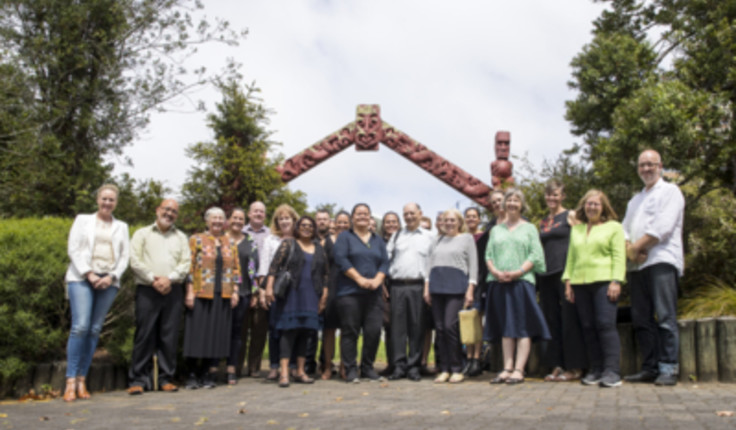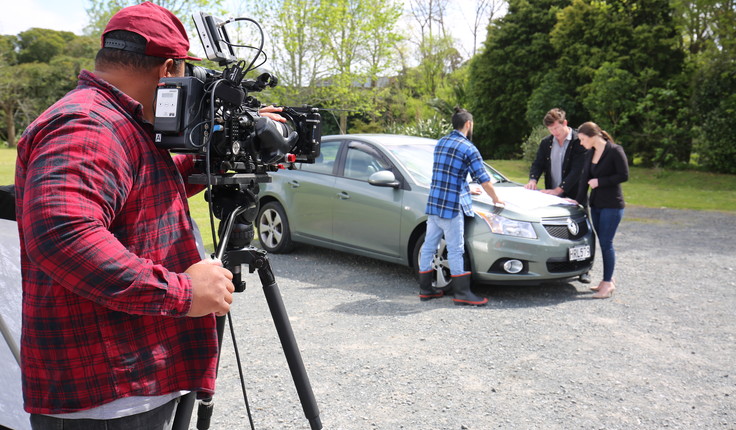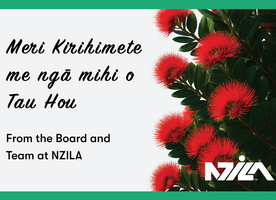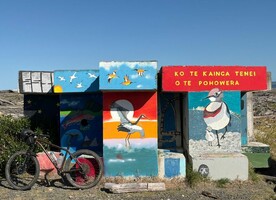News
Better Prepared Built Environment Professions
Posted 23 01 2019
in News

Diane Menzies with Lena Henry and Dory Reeves
Landscape architects will be interested to know that there is a useful, new on-line resource available to help them communicate and work with Māori. This is called Te Whaihanga and includes videos, text-based learning and assessment material, as well as a tool for reflecting on personal experience. It was produced by Auckland University with support from education funders, local government and the built environment professions.
Back in 2015 three landscape architects held workshop sessions in the main centres for landscape architecture students and practitioners. The workshop events led by Alan Titchener, Phil Wihongi and Neil Challenger covered Māori cultural values, and engagement with mana whenua. At about the same time Professor Dory Reeves and Lena Henry of Auckland University were preparing a funding application for a teaching and learning project which would better prepare built environment professions: that is engineering, planning, architecture and landscape architecture students, for working with Māori. The project Te Whaihanga, was named by Māori professionals and community leaders who have steered the project. The project has a complementary vision to that of the 2015 landscape architecture training team: that is, ‘to ensure that future generations of planners, architects, engineers and landscape architects, both Māori and non-Māori, are better prepared for work with Māori professionals, iwi representatives,..’ and ‘to build and sustain positive working relationships with mana whenua.’
Previously the Lincoln University landscape architecture course included marae visits and studio-based teaching and learning on Māori principles and values related to design, led by Neil Challenger. Similarly at Unitec Richard Mann taught a Māori history and values course, and architecture students have Professor Rau Hoskins and Carin Wilson. AUT, and Auckland University built environment students have also been taught by Māori practitioners, notably Rewi Thompson. Te Whaihanga though is the first teaching and learning project on this topic to be shared across universities and programmes, developed specifically for the built environment professions.
Since 2015 there have been educational and cultural changes in the landscape architecture profession, as well as in universities and the market place to respond to the need for better planning and design for and with Māori. Tuia Pito Ora, the New Zealand Institute of Landscape Architects, now has education policies which require graduates to have a more comprehensive understanding of Māori values, principles and cultural practice. Graduate experience assessed for Registation requires an understanding of the Treaty of Waitangi but needs updating to reflect the greater focus on Te Ao Māori. Employers are seeking staff who are able to design for and understand Māori client and community values.
Te Tiriti o Waitangi and the Treaty of Waitangi (reflecting the different language versions) are the legal basis for the need for better cultural understanding from built environment professions, and the foundation of relationships between Māori communities and the Crown. The roles and responsibilities enshrined in the Treaty are passed on to local and regional government. They are also relevant to built environment practitioners through the Resource Management Act which requires that the Treaty principles be recognised. This follows through to national policy and regional and district plans as well as to heritage, conservation and other legislation.
Te Whaihanga is one response to the imperative for better cultural understanding by design professionals. The focus of Te Whaihanga is on students of the built environment professions, where teaching resources for working in the Māori space have been minimal. The resources have also been trialled within Auckland Council, which is a partner in the project, and found to be useful for a range of professions. Urban design consultants and property professions are also likely to find the Te Whaihanga teaches practitioners how to work more effectively and respectfully with Māori.
The contents of Te Whaihanga are briefly outlined in this article, so that landscape architecture practitioners and offices can utilise the same material which is being presented to lecturers and students at Auckland University, Unitec, Victoria University of Wellington, AUT, and Lincoln University. The material could help to keep practitioner staff conversant with the level of knowledge of incoming graduates, as well as assist staff who have come from overseas.
Te Whaihanga Project
The main aim of the Whaihanga project was to produce research-based, on-line teaching and learning material. The outputs are four videos, a text-based learning module, a glossary of Māori words and terms used in the videos and other sections in the publication, a learning assessment tool, and a section on Critical Incident Analysis. The learning assessment section provides questions which can be answered through an online survey: students can respond in class using their cellphones.
Te Whaihanga is a research project: the re-enacted work-related situations shown in the four videos were developed after investigation of the most effective way of communicating cultural issues, were scripted, filmed using Māori actors and built environment staff, and cover four familiar development scenarios. Key audiences are identified in the project report, and an evolved methodology is provided. The research material responds to a need for directly relevant scenarios, concepts and language which occur frequently in professional relationships to do with land and the natural and built environment. The learning assessment tool tests understanding of core values.
In the text-based learning module the reason why students (and practitioners) need to be prepared for engaging with Māori clients and communities is outlined. This includes a brief history of engagement between built environment practitioners and iwi/hapu. The information is profession-specific as well as being inclusive: some of the information is relevant to all built environment professions. An example is reference to the the Te Aranga Cultural Landscape Strategy, developed by Ngā Aho and now posted on the Auckland Council Design Office website as well as being adopted by consulting firms. This strategy locates all environments within the cultural landscape and is relevant to urban design, architecture, planning, landscape architecture and engineering. In addition the specific education, accreditation and ethical responsibilities that apply to the built environment professions in general, and landscape architecture in particular, are included.
What are Te Whaihanga’s video sessions about?
The videos are simple and clear and cover the establishment of a team who will be working on a typical (but fictitious) project for mana whenua, called Whenua WAI; planning for a meeting with mana whenua, an on-site meeting, and kaitiaki and development. The video series is a package, taking watchers through the evolution of a project and what should be considered when the clients, community or users of the site are Māori. They also give particular attention to those who are mana whenua. With 19 iwi/hapu in Auckland the mana whenua context is particularly complex and important to understand. In addition, in Auckland and other places some iwi/hapu have overlapping rohe (territory). In addition, many Māori, termed ngā mataawaka, live outside their home territory, such as in the main centres.
The full text of each video is provided. This might be helpful for those who are unfamiliar with the use of such terms in Māori. There is a guide provided for teachers and facilitators which includes a session plan and questions for a worksheet for the videos. There is also a Critical Incident Analysis (CIA) tool or strategy for critical reflection. This is helpful for teachers or facilitators as well as students in responding to cultural issues raised and where concern or discomfort has been expressed, and encourages deeper learning.
The technique discussed for critical reflection has yet to be more widely adopted in built environment courses but has been found useful for learning in other disciples. This tool might well assist practitioners to enhance learning and address differing perspectives, and is a technique in which I intend to invest time.
Lincoln University’s School of Landscape Architecture integrates the video sessions into their final-year professional practice course and see a strong link into the current planning framework with which all graduates will need to engage. The examiner for this course, Don Royds, notes: “The project was set up for tertiary-level learning, but these aspects are fundamental for any landscape architect working in Aotearoa / New Zealand.” Don has the Professional Development Portfolio for Tuia Pito Ora, the New Zealand Institute of Landscape Architects and also sees the relevance for practicing Landscape Architects in their Continuing Professional Development (CPD). “The videos”, he said, “could be especially useful for smaller practices or those who have yet to engage with iwi on projects.” Don reflected that education and practice have changed considerably within the last 15 – 20 years and that tools like this could also benefit not just recent graduates.
Victoria University of Wellington has a similar approach where the video sessions are used to prepare final year undergraduate landscape architecture students for their design studio. The studio recognises the importance of environmental and social connections and learning from indigenous practices in developing a place-specific and culturally appropriate framework. Bruno Marques from VUW states: “this tool shows students that working in a respectful and empowered manner with iwi is possible, and helps demystify cultural aspects.”
Useful for practitioners, students as well as Māori
Māori have asked that built environment professionals learn to communicate more effectively with Māori so that time is more effectively used and there is a better outcome for all in the community.
The publication responds to that call and so is needed by landscape architecture staff who may come from overseas or those who have had very little experience working with cultures other than those with western values and principles. There are also built environment staff who have found communication with Māori difficult or who may not have appreciated that their communication skills could be more effective. This applies to consultancies as well as government and local body staff who can particularly benefit from the videos and Critical Incident Analysis, outlined in Te Whaihanga.
Auckland Council organised two cohorts with six facilitated sessions in 2018 and now have budget allocated for Te Whaihanga-based training for engineers in 2019. They have a waiting list of 150 engineers for other sessions. Helen Te Hira, Principle Advisor Te Tiriti o Waitangi, Auckland Council, explained that the outcome of the sessions she has facilitated was deeper reflection on experiences in engaging with Māori, using the Critical Incident Tool. This has helped staff build their cultural intelligence and develop expertise to reflect on experiences. Participants have all benefitted, finding the sessions a rare opportunity to debrief. In tandem with the built environment workforce, facilitated sessions are also planned with built environment managers as well as Māori staff, looking at Treaty responses and Auckland Council as an employer. The Māori built environment staff have been expected to carry an extra cultural burden and the training will assist them as well as mana whenua.


Larger landscape architecture consulting firms such as Boffa Miskell could adapt Te Whaihanga material for their staff. Partner of Boffa Miskell Rachel de Lambert said: “We want our staff to have competency in engaging with mana whenua. Professions need to have their own skills rather than defer to someone who has that expertise.” Boffa Miskell also employ specialist advisors to undertake more complex engagement and ‘smooth communications.’ They currently undertake in-house training on working with mana whenua and will investigate the use of Te Whaihanga to consider how it could complement and fit with their training.
Smaller landscape architecture consultancies, which are the majority of landscape firms, are unlikely to have specialist advisers on staff and may not have established in-house training for working with Māori. The Whaihanga module may be useful for them, to ensure all professional staff develop communication skills and knowledge for working with iwi/hapu. Auckland Council are also willing to include in their sessions those built environment professionals in small private practices in Auckland who seek an opportunity for training.
Auckland urban design consultant Tracy Ogden-Cork of Motu Design agrees that more practitioner training would be definitely helpful across various disciplines. She includes property developers and project managers in her list of relevant professions. She has reviewed the Te Whaihanga material and considers that through the approach taken it will help to build people’s confidence in embarking on a path towards better relationships with mana whenua and understanding of important cultural concepts and values.
Back to Te Whaihanga and the tertiary level providers
While tertiary level built environment courses would be in a much better position to provide course-specific skilled teaching if there were many more Māori lecturers for those courses, there is currently as much of a dearth of built environment Māori lecturers as there has been appropriate teaching materials. That is why Lena Henry, the sole Māori planning lecturer at Auckland University and Professor Dory Reeves championed the project, and why Ako Aotearoa, the National Centre of Tertiary Teaching Excellence granted matching funding with Auckland University for this project. Te Whaihanga has been a collaborative project, integrating tertiary educators as well as professional institutes including Tuia Pito Ora New Zealand Institute of Landscape Architects, and other contributors such as Ngā Aho and Auckland Council.
The project report provides a chart illustrating the location and academic levels of the built environment programmes in Aotearoa New Zealand. While noting that 8.5% of the 25,000 students who graduate annually are built environment graduates, of this total of 2100 graduates, half are engineers. The report does not show a further critical statistic: the number of Māori built environment graduates emerging each year from those courses. A snapshot investigation undertaken two years ago by Ngā Aho, the Māori designers network, of numbers of tertiary level Māori graduates from Auckland courses indicated only one or two from each of architecture, planning and landscape architecture courses. Not only are the few Māori built environment graduates hard-pressed to fulfil the planning and design need for working with and for Māori, but there are few emerging graduates to fill the teaching space in future. That is why there is a strong need for all students to develop understanding and communication skills in this area.
The Whaihanga course material can be facilitated by non-Maori, but familiarity with Māori principles and language as well as terms used is needed. The Critical Incident Analysis can also assist learning for both teachers and students. Those courses which have a skilled profession-specific Māori lecturer have an advantage that they can pass on to students.
The next steps
Te Whaihanga was launched by Ako Aotearoa in October and the videos and a flyer can be found on their website. Final editing of the project report is being completed and the report together with links for the videos will soon be available. Built environment teaching material is also now being developed for Pasifika students. A further idea put forward as part of the project review is to adapt the project to different skill levels so that learning can be integrated into courses from year one and consolidated through the courses.
Phil Wihongi, Chair of Te Tau-a-Nuku, the Māori landscape architects section of Ngā Aho, reflects on changes since the training workshops in 2015: “The world seems to be turning faster and faster. The speed highlights the need for more and more people with skills in this area. Those people can be the change.”
Click here for full project information
Share
19 Dec
Christmas break 2025

see you from 12 January
As we wrap up another big year, we’re taking a moment to pause, breathe, and enjoy a well-earned break. Meri …
18 Dec
President’s update

December 2025
Earlier this month I attended the Ngā Aho Māori Design Professionals Wānanga-ā-Tau at Te Aranga Marae in Flaxmere. Tuia Pito …
18 Dec
Awards 2026 update

An update as we warm up for the 2026 Awards kaupapa. Submissions will open in March and will run for …
Events calendar
Full 2025 calendar